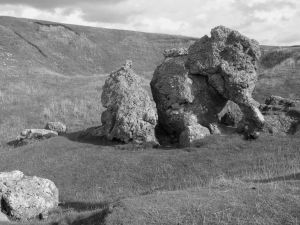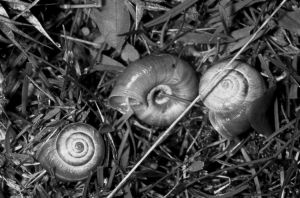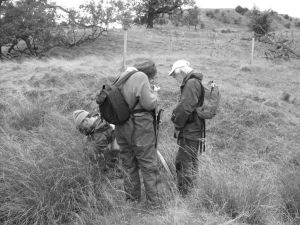|
The recent arrival of Mollusc World provoked several emotions – pleasure (interesting notes, excellent pictures), frustration (these people know so much more than I do) and guilt! Guilt because during the last few years there have been several field meetings in Worcestershire when I was designated ‘leader’. This last always seemed to me to be a misnomer because those attending always knew far more about molluscs than I did and I thought my only duty was to get attendees to the correct location and, following the horrendous Heath & Safety instructions, try to get them off home again in one piece! However, I discovered there was apparently another duty – write an account of the visit for Mollusc World. Hence the guilt – I haven’t done it: excuses, excuses.The final straw was the recent account of a Nottinghamshire Field Meeting from my friend, and another ornithological conchologist, Chris du Feu. If he could do it … … On the 1st October 2005 a small party gathered on the north side of Bredon Hill in south Worcestershire and set off in search of molluscs. Bredon Hill is capped by Oolitic Limestone.The underlying Upper and Middle Lias both emerge on the north side of the Hill beneath the Oolitic escarpment and they also contain limestone bands. Geologically Bredon Hill is the Cotswolds in miniature and is an outlier of the main hills which lie ten miles to the east. Bredon Hill is a pretty limey place and local naturalist John Meiklejohn has recorded a long list of molluscs there over many years. Unfortunately he could not be there on 1st October. As we climbed the hill we started snailing on grazed pasture and continued in a small woodland containing a few ancient trees but mainly a modern plantation of conifer and alder. From there we emerged on to extensive uneven rough pasture lying on the Upper Lias. On this hummocky zone there is a considerable scattering of Oolitic limestone fragments of all sizes derived from the escarpment above; a scattering of solitary ancient ash trees; and several old tumbledown stone walls. Small screes lie at the base of the steep escarpment. From the rough grassland we climbed the steep north-facing grassy slope of the Inferior Oolite to the closely grazed pastures on the earthworks near the tower.After admiring the amazing view we followed a pathway gently sloping south and running alongside a stone wall to a small beech woodland containing another collapsed stone wall. From here we moved down to another area of rough pasture.While traversing the rough grasslands we investigated several wet flushes and a small stream which meanders through a small marsh near the site of a long-deserted village. We found many of the commoner slugs and snails in various habitats. Highlights for me included David Long’s ability to find the tiny snails typical of limestone grassland, apparently with ease! (Thank you Harry. Short sight helps - DCL). One species that fascinated me was Ceciliodes acicula which I had not seen before.The experts headed for disturbed soil to find these and I was pleased to take a couple of shells home to photograph.A pleasing aftermath was to discover that my conchologist mentor John Meiklejohn had not found them on Bredon before! We found the typical larger snails of limestone grassland Cernuella virgata and Candidula intersecta, and were pleased to find an extensive colony of Helicella itala. Live examples of the latter were closely associated with clumps of dead and falling Musk Thistles Carduus nutans – lift a clump and a cluster of snails were hiding within. Nearby, several species of sub-fossil snails could be seen in eroding soil banks including Pomatias elegans – a species which still has colonies on another part of the Bredon Hill.The stone walls are well known for their colonies of Pyramidula rupestris and we found plenty of them under the wall stones and in the scree. Besides molluscs we recorded a few other invertebrates, several harvestmen, hibernating true bugs, the woodlouse hunting spider Dysdera crocata, and in the many ant nests the blind white woodlouse Platyarthrus hoffmanseggi In all, our visit to Bredon Hill provided a very enjoyable day with excellent weather and clear visibility allowing outstanding views of the Coloured Counties. Most of the area visited is designated SSSI and we are grateful to the owner Mark Steele for allowing us access.We plan another visit to the nearby National Nature Reserve with its limey pastures, scrub, old trees, boggy slumps, stone walls, marshy uplands, and the Great Mud Slide.Why don’t you come along? Harry Green. (Rosemary Hill, Ron Boyce, and David Long). Molluscs found Bredon Hill,Worcestershire, 1st October 2005.
|
|
An October day on Brendon
Issue
10
Page
4

 1. The elephant stone on top of Bredon Hill amongst grazed limestone grassland. Picture R Hill
1. The elephant stone on top of Bredon Hill amongst grazed limestone grassland. Picture R Hill 2. Helicella itala found on Bredon Hill. Picture R Boyce
2. Helicella itala found on Bredon Hill. Picture R Boyce 3. Snailing party confer on Bredon Hill rough grassland: Left to right David Long, Rosemary Hill and Harry Green. Picture R Boyce.
3. Snailing party confer on Bredon Hill rough grassland: Left to right David Long, Rosemary Hill and Harry Green. Picture R Boyce.